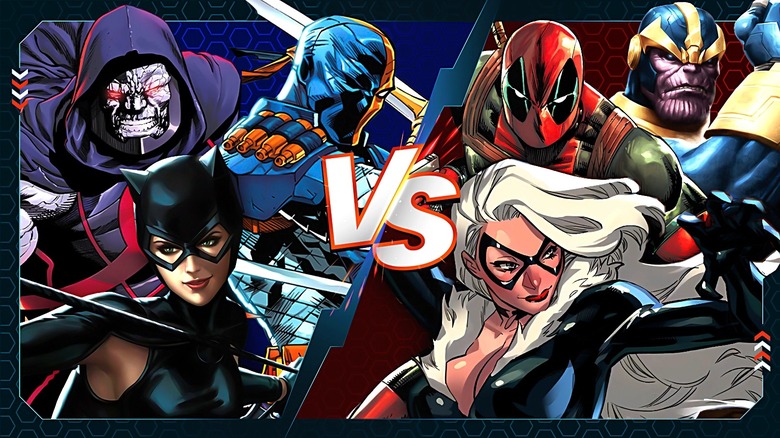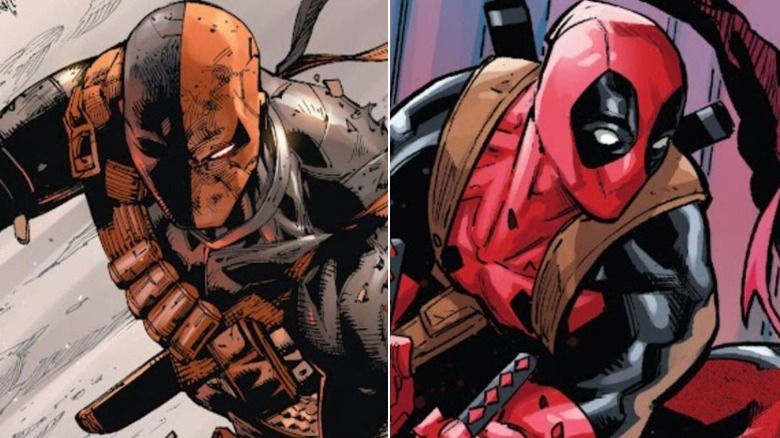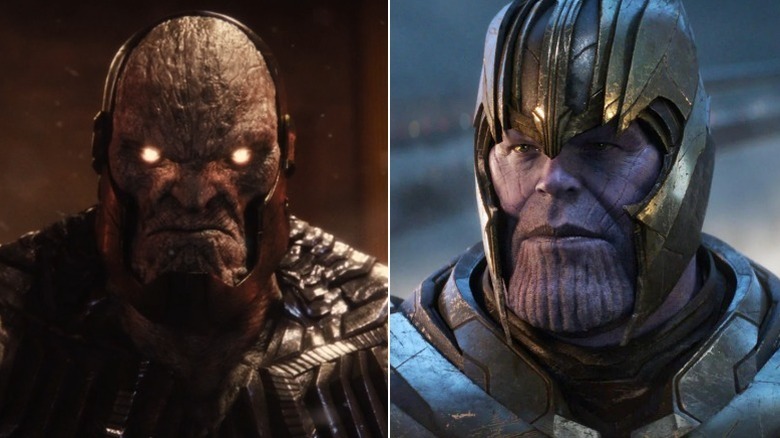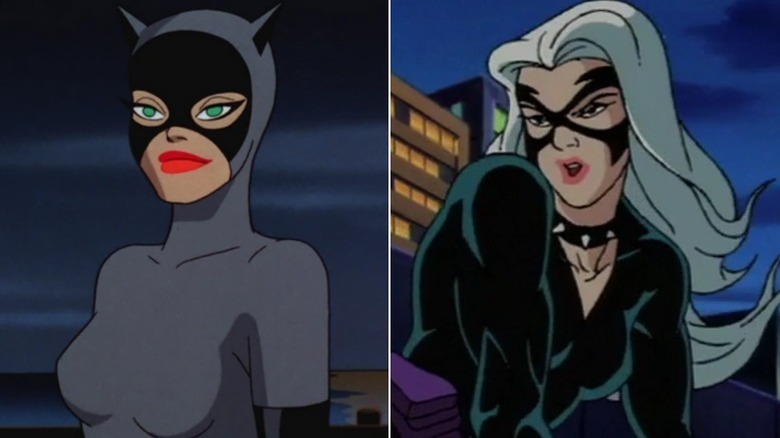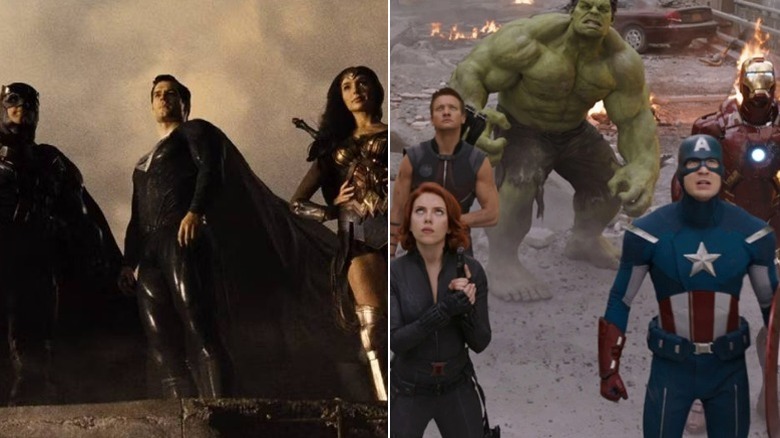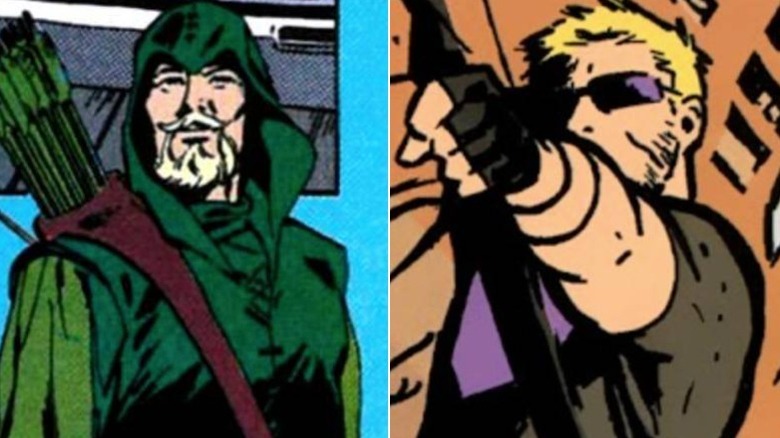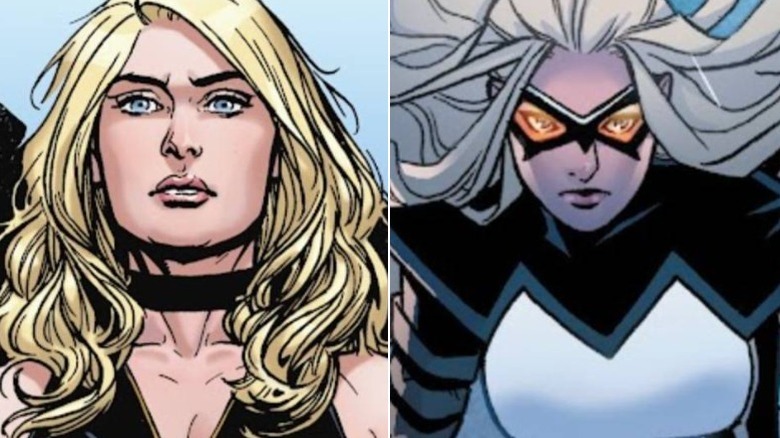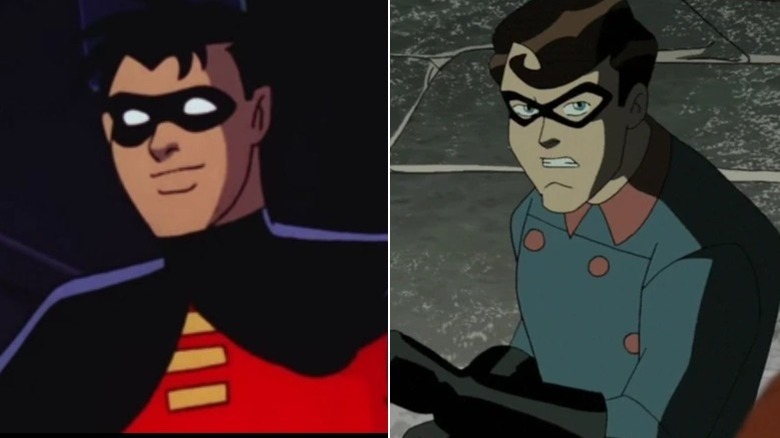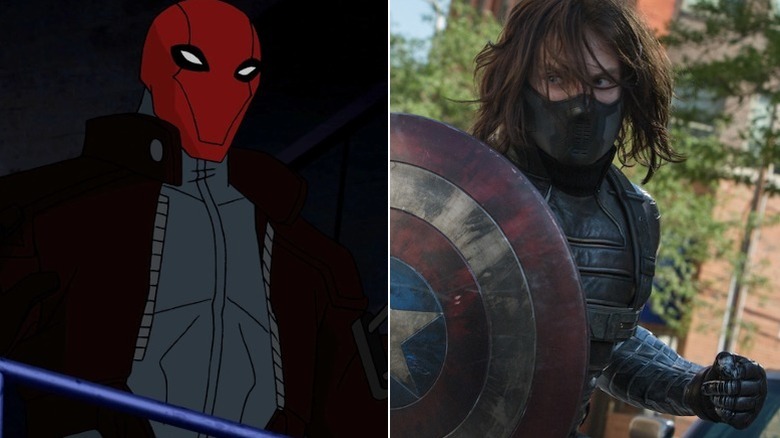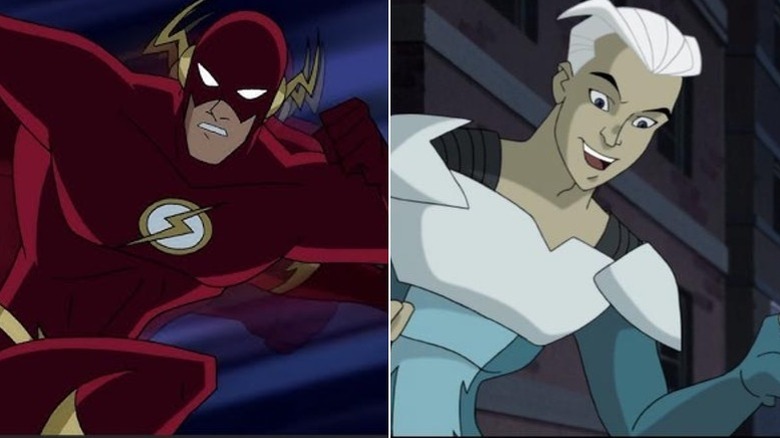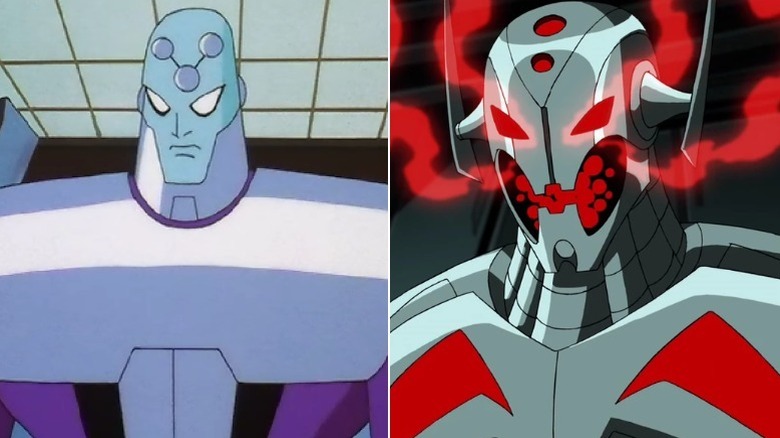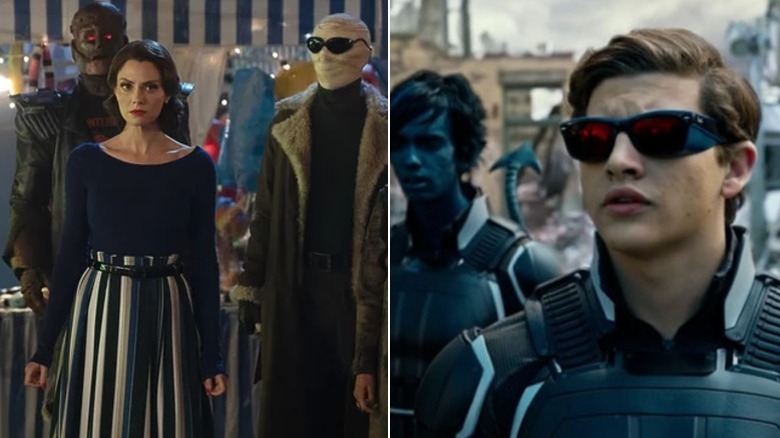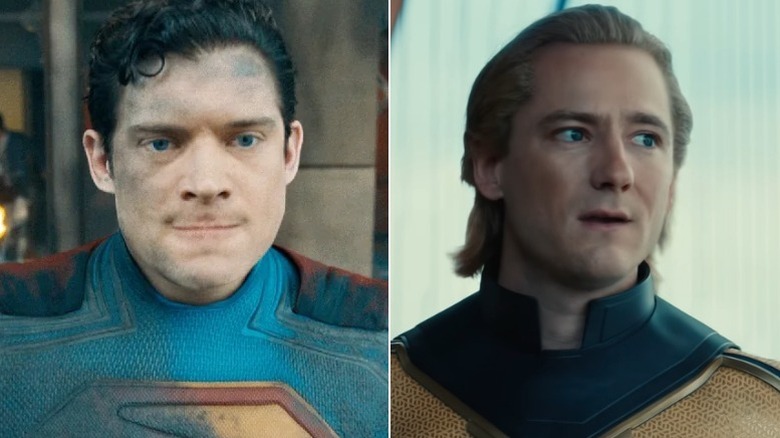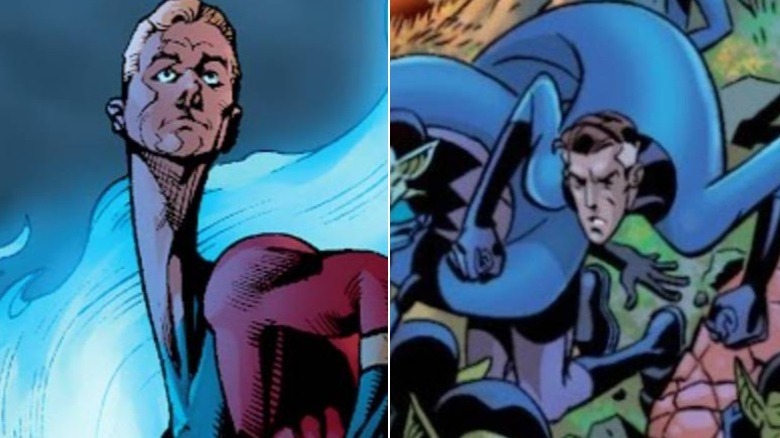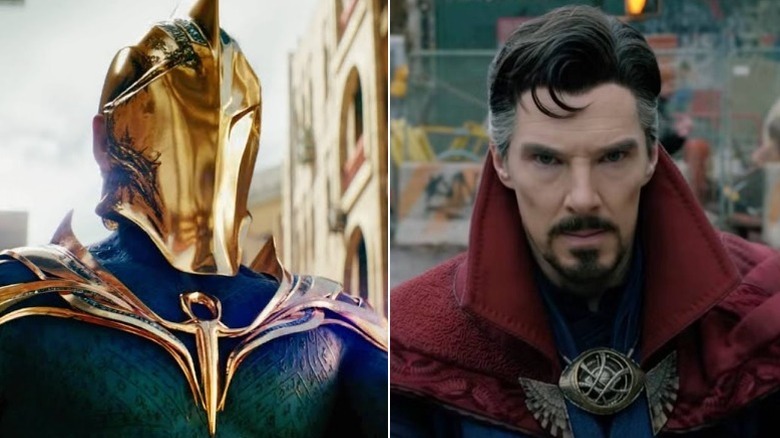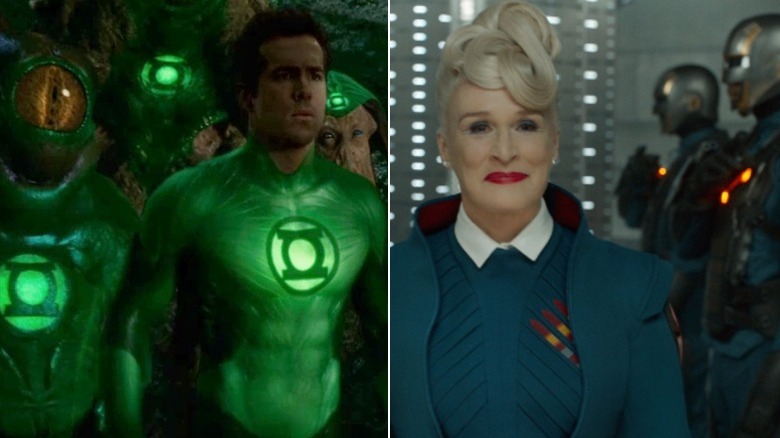15 Times Marvel Blatantly Copied DC Comics
We may receive a commission on purchases made from links.
There are only so many original ideas. Anyone trying to come up with a new screenplay or write a song will likely find that whatever they come up with has been done plenty of times in the past. True ingenuity is tough to come by, and parallel thinking is more common than you might expect. But that doesn't mean our eyebrows don't raise when two characters from rival comic book companies seem awfully similar.
Marvel and DC have been the top two in the comic book business for decades. Each one has a roster of heroes and villains that have inspired countless cartoons and live-action films. Of course, they share writers and artists, so it's a friendly rivalry if nothing else. And sometimes it really does feel like one has ripped off the other, like when Marvel introduced its hero team-up just a few years after DC did. To be clear, in many of these cases, there's no hard evidence that outright plagiarism took place. But it really does feel like there are ample cases where Marvel blatantly copied a character who originated at DC.
Deathstroke and Deadpool
At first glance, it seems like Deadpool could've only existed as a Deathstroke parody. They're both merciless assassins proficient with bladed weapons. Their costumes look similar, and they even have pretty much the same name ... in both cases. Deathstroke isn't that far off from Deadpool while their names are Slade Wilson and Wade Wilson, respectively. Deathstroke also had a full decade to influence his successor, as he first debuted in 1980's "New Teen Titans" #2. In an astonishing coincidence, Deadpool also first appeared in a young superhero outfit's comic with the word "New" in the title, making his debut in 1990's "The New Mutants" #98.
Deadpool creator Rob Liefeld insists the idea for Deadpool actually came from the G.I. Joe assassin, Snake Eyes. Of course, the biggest different between Deadpool and both Snake Eyes and Deathstroke is his profane sense of humor. Liefeld continues to debunk such claims Deadpool ripped off Deathstroke, and the Merc with the Mouth has surpassed his predecessor on the big screen. There's a full "Deadpool" movie franchise while Deathstroke couldn't even make good on his "Justice League" post-credits scene.
Darkseid and Thanos
Deadpool may not have technically ripped off Deathstroke, but Thanos' creator is more than happy to give credit where it's due. Darkseid emerged as a force to be reckoned with in the DC universe within "Superman's Pal Jimmy Olsen" #134 in 1970. Yeah, no joke. Darkseid first appeared in a Jimmy Olsen comic but would soon go on to threaten all life as we know it. He was created by Jack Kirby, who originally wanted to make him a Marvel character, but he became one of DC's New Gods, who wants to subjugate the universe to his whim using the anti-life equation.
Thanos first appeared in "The Invincible Iron Man" #55 in 1972, and in later stories, the Mad Titan would seek out the Infinity Gems to impress Lady Death (or restore balance by wiping out half of all life in the Marvel Cinematic Universe). Thanos' creator, Jim Starlin, was originally going to give Marvel a version of a different DC villain — Metron. However, he was told to make him bigger up so that he'd resemble a different New God, namely Darkseid. The result is two powerful, space-based antagonists who are always searching for some grand mechanism to shape the universe to what they want it to be.
Catwoman and Black Cat
A feline-centric antagonist who's a literal cat burglar is the kind of idea anyone could have. But it's a little suspicious that both Batman and Spider-Man have a cat villain who's occasionally an anti-hero as well as an on-again/off-again romantic interest.
Selina Kyle, aka Catwoman, predates Black Cat by several decades, going all the way back to 1940's "Batman" #1. Felicia Hardy (read: Black Cat) wouldn't become a fixture of Marvel Comics until 1979's "The Amazing Spider-Man" #194. They're both femme fatales who learn about their respective heroes' identities at various points, but Black Cat's creator, Marv Wolfman, has stated she wasn't always meant to be a Spider-Man villain.
He first wanted to put her in a Spider-Woman comic and was more influenced by Tex Avery's "Black Luck Blackie" cartoon from 1949, which is about a black cat that brings bad luck wherever it goes. Occasionally, Black Cat possesses a "bad luck aura" superpower that influences probability fields, which is probably enough to differentiate her from her DC counterpart.
Justice League and the Avengers
It feels weird that it took DC and Marvel so long to realize "Hey, we should take our most popular heroes and put them in a team." The former beat the latter to the punch with the Justice League debuting in "The Brave and the Bold" #28, fighting Starro in 1960. Stan Lee and Jack Kirby worked on "The Avengers" #1, which came out in 1963. One could argue that Marvel's first attempt of a superhero team was the Fantastic Four, but even then, they still came out in 1961, a year after the Justice League.
However, it was Marvel that would get the last laugh. 2012's "The Avengers" changed superhero cinema by proving an expansive on-screen universe could be financially lucrative. DC tried to get their own interconnected franchise off the ground with 2017's "Justice League" (which was ruined by a studio note to make it funnier). The DC Extended Universe floundered, and even with Zack Snyder's director's cut coming out to show what his four-hour "Justice League" would've looked like, the damage was done.
Green Arrow and Hawkeye
Is it fair to call Hawkeye a Green Arrow ripoff since they're both superheroes who use bows and arrows? After all, the latter feels like a carbon copy of Robin Hood, down to his signature color scheme. But when it came to making an archer a staple of a comics roster, DC beat Marvel by a pretty far margin.
Green Arrow's older than most people probably think, making his debut in "More Fun Comics" #73 in 1941 alongside his trusted sidekick, Speedy. Hawkeye had a very different introduction in 1964's "Tales of Suspense" #57 as a villain, albeit a reluctant one. He fights Iron Man in that comic and teams up with what would become his long-time ally, Black Widow.
The similarities wouldn't end with just the archery set. They would both become known for using trick arrows for different attack styles in battle, and they would each join the line-up of their respective superhero teams — the Justice League and the Avengers.
Black Canary and Mockingbird
Another fascinating similarities between Green Arrow and Hawkeye is that they both have romantic relationships with co-workers who have bird-themed codenames. We're talking about Black Canary, who was introduced in 1947's "Flash Comics" #87, and Mockingbird, who was introduced as Dr. Barbara Morse years prior to her donning her superhero moniker in 1980's "Marvel Team-Up" #95.
Green Arrow and Hawkeye might be a coincidence, but Mockingbird was apparently fully inspired by Black Canary. Mark Gruenwald came up with the concept, planning on using Mockingbird for Spider-Woman, but it never came to be. He then gave Steven Grant the character to use for "Marvel Team-Up." Grant explained in an interview featured in TwoMorrows' Back Issue #56, "Mark's early love was always DC superheroes, and he had a long-term dream of creating a Marvel version of the Justice League ... One of the characters in Marvel's notebook was a Marvel-earth version of Black Canary, who in Mark's version was in fact black, who he intended to pair up with Hawkeye."
Robin and Bucky Barnes
Sidekicks are synonymous with superheroes, and the world has Robin and Bucky Barnes to thank for that. Once again, DC just barely nudged Marvel out of claiming the top spot. Robin first made his entrance as Batman's protégé in "Detective Comics" #38 in 1940. Bucky Barnes has been around since "Captain America Comics" #1, but that didn't come out until a year later. While their origin would later be retconned to being good friends, Bucky was originally Cap's kid sidekick, tagging along on adventures.
Unfortunately, Stan Lee wasn't a fan of such sidekicks, which ultimately led to Bucky's death. Years after Cap's introduction, Lee wanted to bring him into the Avengers but didn't want Bucky around, so he was killed off. It helps highlight the danger a literal child would have going on adventures with a superhero regularly dodging bad guys. But little did Lee know he was setting the stage for Robin and Bucky to be more similar than ever...
Red Hood and Winter Soldier
Out of any other entry on this list, this might be the weirdest case of parallel thinking because both publishers had writers come up with the idea of resurrecting a dead sidekick and making them a new antagonist for their former partner. In the world of Batman, Dick Grayson was allowed to grow up and become Nightwing, but the next Robin, Jason Todd, would die at the hands of the Joker. In February 2005, Todd would return as the vigilante Red Hood in "Batman" #635.
Just a couple of months later, "Captain America" #6 would introduce a new foe for Steve Rogers — the Winter Soldier, who would eventually be revealed to be his deceased partner, Bucky. This particular storyline from Ed Brubaker and Steve Epting is honestly the best Captain America comic to read to get into this universe.
There's no way one publisher could've been aware of what the other was about to do. If anything, both Red Hood and Winter Soldier feel like responses to a post-9/11 world, exploring themes of lost innocence where a former plucky sidekick becomes twisted and warped into something unrecognizable.
The Flash and Quicksilver
Super speed isn't a particularly unique ability. If you ask a bunch of people what superpower they would want most, there's a good chance quite a few of them would respond with unimaginable speed. As such, it's probably no surprise both DC and Marvel have popular characters whose primary attribute is super speed, not counting someone like Superman who is very fast but also has a bunch of other powers.
"Flash Comics" #1 introduced Jay Garrick, the first ever Flash, all the way back in 1940. Various others would don the Flash mantle, from Barry Allen to Wally West, over the years, but the Flash in some form has been kicking around for nearly a century at this point. Quicksilver wouldn't debut in Marvel until 1964's "The X-Men" #4. The biggest difference between the two is that Quicksilver, aka Pietro Maximoff, began as a villain within the Brotherhood of Evil Mutants; however, he has gone toward the side of good on occasion, even joining the Avengers.
Brainiac and Ultron
Fears surrounding artificial intelligence have endured for decades, as evidenced by DC and Marvel both coming up with AI threats that often require teams of superheroes to defeat. Brainiac has gone through various permutations over the years, but he first showed up on the scene in "Action Comics" #242 in 1958. In his initial origin, he travels the cosmos searching for great civilizations to acquire their knowledge and keep cities in jars. Basically, he's obsessed with knowing everything and sees planets and their respective populations as a nuisance to get it. His advanced intellect makes him one of the strongest Superman villains of all time.
Ultron was first mentioned by name in "The Avengers" #55, which came out a decade later in 1968. Ultron also usually has a mission to wipe out all of humanity, seeing them as a threat to overarching peace. Whereas Hank Pym created Ultron in the comics, Tony Stark (Robert Downey Jr.) and Bruce Banner (Mark Ruffalo) developed the AI in "Avengers: Age of Ultron." Either way, it makes him an example of mankind's hubris and provides an added layer that something humans created turned out to be such a destructive power.
Doom Patrol and X-Men
The X-Men contain some of the most popular heroes in comic book history, but there's the question as to whether they were lifted straight from DC's Doom Patrol. They're both superhero teams of misfits and outcasts that are led by a genius in a wheelchair. Like Red Hood and Winter Soldier, this is another one where it feels like they came out too close together to be direct copies. Doom Patrol came out in "My Greatest Adventure" #80 in June 1963. "X-Men" #1 came out in September that same year. Again, parallel thinking might be the most reasonable explanation. They both came out in the midst of the Civil Rights movement with both teams serving as allegories for people fighting for acceptance.
However, Doom Patrol creator Arnold Drake gave an interview to Newsarama in 2007 where he claimed Stan Lee stole his idea and offered the following as evidence: "Over the years I learned that an awful lot of writers and artists were working surreptitiously between the two offices [Marvel and DC] ... It would've been easy for someone to walk over and hear that this guy Drake is working on a story about a bunch of reluctant superheroes who are led by a man in a wheelchair."
Superman and Sentry
If you're going to steal a superhero, you might as well steal the best. Superman premiered in "Action Comics" #1 in 1938, making him among the oldest superheroes. Over the years, Marvel has created its own iterations of the Man of Steel, like Hyperion, an all-powerful being who possesses many of Superman's powers. Usually, there's some kind of twist on the Superman archetype, like Homelander from "The Boys," who's pretty much that universe's Superman except he's a neurotic villain who wants everyone to bow down to him.
Marvel developed a unique twist on Superman with "Sentry" #1 in 2000. The comic introduced Bob Reynolds, aka Sentry, who develops immense abilities after experimentation. Unfortunately, this also unleashes a powerful malevolent entity within him called the Void that seeks to envelop everything in darkness. Considering that Superman is all good, it makes sense other comic book writers would toy around with that idea and posit what would happen if someone with Superman's strengths wasn't such a great guy.
Elongated Man and Mr. Fantastic
DC technically had two stretchy heroes before Marvel got Mr. Fantastic, aka Reed Richards of the Fantastic Four. Quality Comics had Plastic Man dating back to the 1940s, but DC bought the company and its roster of heroes in 1956. Apparently, someone at DC didn't get the memo, as they created yet another stretchy hero with Elongated Man, aka Ralph Dibny, in 1960's "The Flash" #112. As mentioned previously, the Fantastic Four didn't grace the cover of a Marvel comic until 1961.
Despite having similar powers, the two characters are pretty different. Elongated Man was more of a comical character in his initial run although things did get admittedly dark for him in the "Identity Crisis" storyline. On the other hand, Mr. Fantastic has always been portrayed as one of the smartest men in the universe where his mind is more of his superpower than his ability to contort his body into all sorts of shapes.
Doctor Fate and Doctor Strange
When you need an excuse to make a character super powerful, just say it's magic. DC did that with Doctor Fate, who debuted in "More Fun Comics" #55 in 1940. For his first few decades, he mostly remained relegated to team-up comics, like appearing within the Justice Society of America. He's in that same group in "Black Adam" where he's the best character in the whole film. Doctor Strange would materialize years later in "Strange Tales" #10 in 1963.
The two being sorcerers make them similar enough, but when you really get down into the nitty-gritty, it's hard not to see some influence even aside from them both having doctorates apparently. They each possess a mystical cloak; Fate has the Cloak of Destiny while Strange uses the Cloak of Levitation. They also have specialized bases — the Tower of Fate and Sanctum Sanctorum, respectively. And just like Fate frequently being affiliated with the JSA, Strange has been part of the Avengers, as well as other groups like the Midnight Sons.
Green Lantern Corps and Nova Corps
Green Lantern has been around since the 1940s. Some people may not realize the original Green Lantern was a guy named Alan Scott, not Hal Jordan. He wouldn't be introduced until 1959's "Showcase" #22, which also expanded the hero's mythos. He was now an intergalactic cop with an entire battalion backing him up known as the Green Lantern Corps.
Marvel also loves itself a cosmic story, and that part of the universe got expanded in 1976 with "The Man Called Nova." Richard Rider, aka Nova, receives great powers from Rhomann Dey, the last and dying member of the Nova Corps, and Richard becomes a superhero in the process. It's pretty similar to typical Green Lantern stories where a dying alien crashes to Earth, and Hal Jordan receives the Green Lantern ring. Later comics would introduce the Nova Corps in greater detail, who protect the universe against forces of evil. Despite a "Nova" movie having a lot of potential within the MCU, Green Lantern is the only one who's made it to the big screen, but that didn't exactly work out too well.
